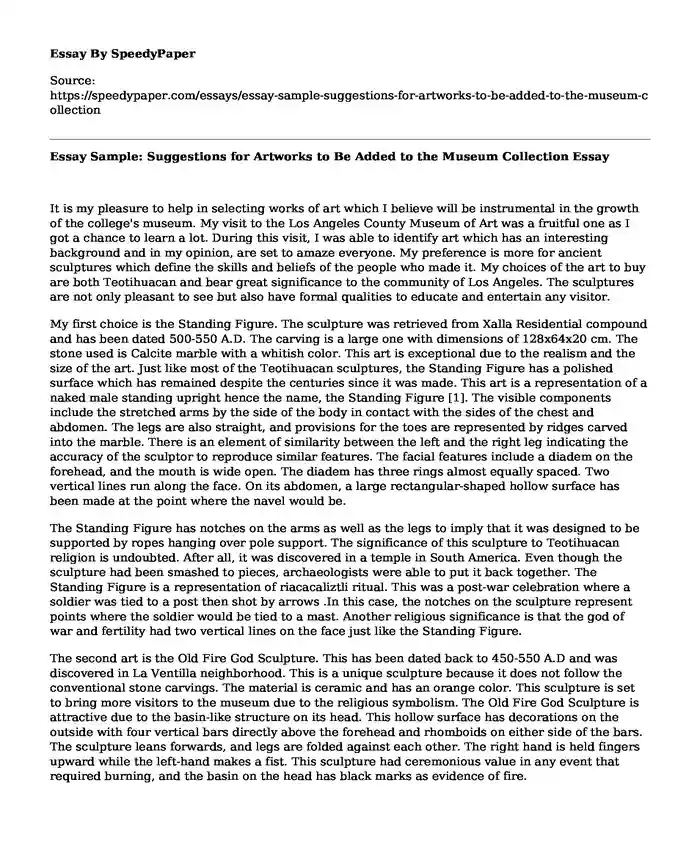It is my pleasure to help in selecting works of art which I believe will be instrumental in the growth of the college's museum. My visit to the Los Angeles County Museum of Art was a fruitful one as I got a chance to learn a lot. During this visit, I was able to identify art which has an interesting background and in my opinion, are set to amaze everyone. My preference is more for ancient sculptures which define the skills and beliefs of the people who made it. My choices of the art to buy are both Teotihuacan and bear great significance to the community of Los Angeles. The sculptures are not only pleasant to see but also have formal qualities to educate and entertain any visitor.
My first choice is the Standing Figure. The sculpture was retrieved from Xalla Residential compound and has been dated 500-550 A.D. The carving is a large one with dimensions of 128x64x20 cm. The stone used is Calcite marble with a whitish color. This art is exceptional due to the realism and the size of the art. Just like most of the Teotihuacan sculptures, the Standing Figure has a polished surface which has remained despite the centuries since it was made. This art is a representation of a naked male standing upright hence the name, the Standing Figure [1]. The visible components include the stretched arms by the side of the body in contact with the sides of the chest and abdomen. The legs are also straight, and provisions for the toes are represented by ridges carved into the marble. There is an element of similarity between the left and the right leg indicating the accuracy of the sculptor to reproduce similar features. The facial features include a diadem on the forehead, and the mouth is wide open. The diadem has three rings almost equally spaced. Two vertical lines run along the face. On its abdomen, a large rectangular-shaped hollow surface has been made at the point where the navel would be.
The Standing Figure has notches on the arms as well as the legs to imply that it was designed to be supported by ropes hanging over pole support. The significance of this sculpture to Teotihuacan religion is undoubted. After all, it was discovered in a temple in South America. Even though the sculpture had been smashed to pieces, archaeologists were able to put it back together. The Standing Figure is a representation of riacacaliztli ritual. This was a post-war celebration where a soldier was tied to a post then shot by arrows .In this case, the notches on the sculpture represent points where the soldier would be tied to a mast. Another religious significance is that the god of war and fertility had two vertical lines on the face just like the Standing Figure.
The second art is the Old Fire God Sculpture. This has been dated back to 450-550 A.D and was discovered in La Ventilla neighborhood. This is a unique sculpture because it does not follow the conventional stone carvings. The material is ceramic and has an orange color. This sculpture is set to bring more visitors to the museum due to the religious symbolism. The Old Fire God Sculpture is attractive due to the basin-like structure on its head. This hollow surface has decorations on the outside with four vertical bars directly above the forehead and rhomboids on either side of the bars. The sculpture leans forwards, and legs are folded against each other. The right hand is held fingers upward while the left-hand makes a fist. This sculpture had ceremonious value in any event that required burning, and the basin on the head has black marks as evidence of fire.
As described above, Teotihuacan art has a lot of relevance, and there is always a story behind the sculptures. A good look at the Standing Figure and the Old Fire God gives an insight into religious practices in ancient Mexico. During my time at the Los Angeles County Museum of Art, I was able to observe that, many people spent more time at the two sculpture, and hence I believe they could be an excellent addition to the Santa Monica College Museum. Having such great art will not only benefit the students whose aim is to learn but also, the members of the local community who want to gain new experiences and to understand art. I hope that the curatorial committee will consider my request and find the details of this research fascinating. Thank you for making me part of this great project.
Sincerely,
Your Name
Bibliography
Arnason, H. H., and Elizabeth C. Mansfield. History of Modern Art (Paperback). Pearson Higher Ed, 2012.
Miller, Mary Ellen. The art of Mesoamerica: from Olmec to Aztec. Thames & Hudson, 2006.
Robb, Matthew. Teotihuacan: City of Water, City of Fire. Univ of California Press, 2017.
Cite this page
Essay Sample: Suggestions for Artworks to Be Added to the Museum Collection. (2022, May 26). Retrieved from https://speedypaper.com/essays/essay-sample-suggestions-for-artworks-to-be-added-to-the-museum-collection
Request Removal
If you are the original author of this essay and no longer wish to have it published on the SpeedyPaper website, please click below to request its removal:
- Democracy in America Essay for Free Use
- Free Essay Example on Demand and Supply of Gasoline
- Teaching Essay Example on Sinking and Floating
- Essay Sample Trying to Determine Boundaries to Informed Consent
- 1. The Introductory Paragraph
- Essay Example on Dealing With Conflict: Understanding Styles and Strategies
- Essay Sample: What is your initial response to Rachael Lloyd's introduction?
Popular categories





